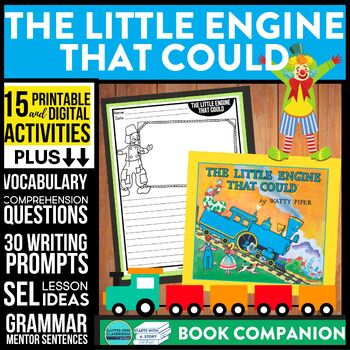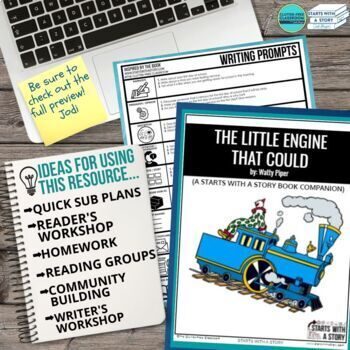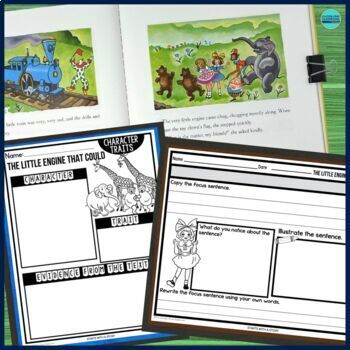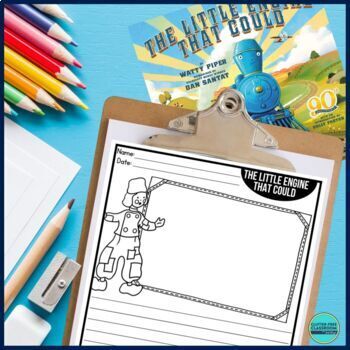THE LITTLE ENGINE THAT COULD activities READING COMPREHENSION - Book Companion
- PDF
- Google Apps™
- Internet Activities

What educators are saying
Description
Save yourself time and engage your students with these The Little Engine that Could activities. This jam-packed book companion is quick and easy to use - Just print and go!
Read on to learn more about all that is included in this standards-based interactive read aloud packet based on the children’s book, The Little Engine that Could by Watty Piper.
TO SAVE YOU TIME, WE'VE DONE ALL OF THE WORK FOR YOU!
1. We chose vocabulary words & kid-friendly definitions.
2. We selected mentor sentences & specific grammar skills for each.
3. We wrote 30 book-based writing prompts (that cover 10 genres of writing).
4. We identified an SEL focus / character education topic based on events in the story.
5. We constructed strategy-based reading comprehension questions and created no-prep, print-and-go reader response worksheets.
YOU ONLY NEED TO DO 3 QUICK & EASY STEPS:
STEP 1: PLAN
Simply customize your The Little Engine that Could lesson plans using the ideas in the teaching guide and choose from the 15 standards-based activities.
STEP 2: PREP
Prep can be as simple as printing the activity pages (or assigning the included digital version) and finding a free video of the book being read aloud online.
OPTIONAL: If you want to dive deeper into a book study, you’ll find our teaching ideas and slides make it easy to create mini-lessons, anchor charts, and slideshows.
STEP 3: TEACH
Engage your students with an interactive read aloud by reading or streaming the picture book. Practice reading comprehension strategies with text-based discussion questions. We even wrote the The Little Engine that Could comprehension questions for you!
Some teachers like to assemble and assign independent work packets. Others prefer to dive deeper into the story with vocabulary, grammar, SEL, and writing lessons that can span over several days.
The best thing about our 500+ book companions is the flexibility they provide you. We’ve packed them with a variety of teaching ideas and activities so you have the option to use them in the way that works best for you and your students!
We have over 500 picture book companions to choose from? ➔ ➔ SEE THEM ALL HERE
THE LITTLE ENGINE THAT COULD BOOK COMPANION FOCUSES ON:
◼️READING SKILLS
☐ SEQUENCING
☐ ANALYZING CHARACTER
☐ IDENTIFYING THE MAIN IDEA
☐ SUMMARIZE/RETELL
◼️GRAMMAR
☐ ADJECTIVES
☐ ONOMATOPOEIA
◼️SEL
☐ RESILIENCY
☐ POSITIVE SELF-TALK
THE LITTLE ENGINE THAT COULD SUMMARY
The story The Little Engine that Could is about a little red train that breaks down when carrying toys, dolls, and great food to the boys and girls on the other side of the mountain. The toys and dolls ask passing engines to help them and pull them to the other side of the mountain but the trains say no.
The toys and dolls do not give up and they ask a Little Blue Engine if she can pull them. The Little Blue Engine says that she has never done that before but she sees that they really need her help. The Little Blue Engine agrees to try to pull them and repeats “I think I can, I think I can” while doing it. She is able to pull the food, toys and dolls to the boys and girls on the other side of the mountain.
HOW THIS RESOURCE SAVES YOU TIME and IMPROVES STUDENT LEARNING:
♥ The comprehension questions are grouped by reading strategies for easy lesson planning.
♥ It is standards-based and covers all aspects of language arts instruction.
♥ The activities were designed to be open-ended for easy differentiation and modification.
THE BOOK COMPANION PACKET CAN BE USED FOR:
→ sub plans
→ reader's workshop
→ guided reading
→ small group instruction
→ independent work
→ literacy centers
→ informal assessment
→ writer's workshop
→ RTI
→ word study
→ guidance lessons for social emotional learning
→ for remote learning, distance learning, or paperless work in the classroom
INCLUDED READ ALOUD LESSON IDEAS & PICTURE BOOK ACTIVITIES:
➜ Comprehension Questions categorized by reading strategy; text-dependent
➜ Social Emotional Learning guidance lesson ideas & discussion topics based on the story
➜ Vocabulary Activities with kid-friendly definitions
➜ Grammar Topics selected to align with the text
➜ Focus Sentences use the book & author's craft as a mentor text to improve writing
➜ Lesson Planner summary, background info and planning space
➜ Story Mapping Printable identify character, setting, problem and solution
➜ Making Words Activity Page use any word from the book
➜ Focus Sentence copy work, identifying elements of the sentence, rewriting
➜ Design a New Book Cover demonstrate understanding of the text by creating an illustration
➜ Predicting Activity primary-ruled and wide-ruled versions
➜ Summarizing Somebody → Wanted → But → Then → Finally
➜ Comparing and Contrasting using a Venn Diagram
➜ Cause and Effect analyze how events affect one another
➜ Visualization illustrate visualizations from the story and support thinking with text-based evidence
➜ Making Connections identify text-to-self, text-to-text, and text-to-world connections
➜ Thematic Writing Paper Use with the Writing Prompts... Makes a Great Bulletin Board
➜ 2 Sequencing Activities First → Next → Then → Last and Beginning → Middle → End
➜ 2 Vocabulary Activities Vocabulary Booklet and Word Mapping
➜ 2 Character Trait Activities listing traits and supporting traits with text-based evidence
➜ 30 Text-Based Writing Prompts 3 prompts for each of the following types of writing:
- narrative
- persuasive / opinion
- descriptive
- expository / informative
- creative / story writing
- procedure / how-to
- list making
- letter / postcard writing
- poem
- book reviews
INCLUDED DIGITAL ACTIVITIES:
➜ 5 Teaching Slides with clipart from the story to use for instruction (add questions, vocabulary, instructions, etc)
➜ 15 Student Pages for use in Google™️ Classroom or as editable files to create customized printables
The 20 slides above can be exported to be used with PowerPoint, Seesaw™️, or another platform.
THESE BOOK COMPANIONS HAVE BEEN USED AND LOVED BY. . .
→ classroom teachers
→ school librarians / media specialists
→ reading specialists
→ homeschool families
→ special education teachers
→ ELL / ESOL teachers
→ school counselors
→ speech language pathologists
→ reading interventionists
→ literacy coaches
→ substitute teachers
VISIT OUR LET'S GET CONNECTED PAGE TO CHOOSE FROM . . .
◼️THE EMAIL CLUB → weekly freebies
◼️FACEBOOK GROUP → a supportive community of elementary teachers
◼️THE TPT STORE → new resources 50% off
◼️THE BLOG → teaching tips and ideas
◼️INSTAGRAM → a look behind the scenes
STANDARD ALIGNMENT FOR ALL STARTS WITH A STORY BOOK COMPANIONS
This resource can be used to teach any state standards. We aligned it with the CCSS, TEKS, and FLORIDA B.E.S.T. STANDARDS below.
COMMON CORE STATE STANDARDS
FIRST GRADE CCSS
- READING LITERATURE: CCSS.RL.1.1 CCSS.RL.1.2 CCSS.RL.1.3 CCSS.RL.1.4 CCSS.RL.1.7 CCSS.RL.1.9
- READING FOUNDATIONAL SKILLS: CCSS.RF.1.1 CCSS.RF.1.1a
- WRITING: CCSS.W.1.1 CCSS.W.1.2 CCSS.W.1.3 CCSS.W.1.5
- LANGUAGE: CCSS.L.1.1 CCSS.L.1.1a CCSS.L.1.1b CCSS.L.1.1c CCSS.L.1.1eCCSS.L.1.1f CCSS.L.1.1h CCSS.L.1.2a CCSS.L.1.2b CCSS.L.1.2d CCSS.L.1.2e CCSS.L.1.5c CCSS.L.1.6
- SPEAKING AND LISTENING: CCSS.SL.1.1 CCSS.SL.1.1a CCSS.SL.1.1b CCSS.SL.1.1c CCSS.SL.1.2
SECOND GRADE CCSS
- READING LITERATURE: CCSS.RL.2.1 CCSS.RL.2.2 CCSS.RL.2.3 CCSS.RL.2.5 CCSS.RL.2.6 CCSS.RL.2.7 CCSS.RL.2.9
- READING FOUNDATIONAL SKILLS: RF.2.3 RF.2.4.c
- WRITING: CCSS.W.2.1 CCSS.W.2.2 CCSS.W.2.3 CCSS.W.2.5
- LANGUAGE: CCSS.L.2.1 CCSS.L.2.1e CCSS.L.2.3 CCSS.L.2.4a CCSS.L.2.6
- SPEAKING & LISTENING: CCSS.SL.2.1 CCSS.SL.2.1a CCSS.SL.2.1b CCSS.SL.2.1c CCSS.SL.2.2 CCSS.SL.2.3
THIRD GRADE CCSS
- READING LITERATURE: CCSS.RL.3.1 CCSS.RL.3.2 CCSS.RL.3.3 CCSS.RL.3.4 CCSS.RL.3.5 CCSS.RL.3.6 CCSS.RL.3.7 CCSS.RL.3.9
- READING FOUNDATIONAL SKILLS: RF.2.3 RF.2.4c
- WRITING: CCSS.W.3.1 CCSS.W.3.2 CCSS.W.3.3 CCSS.W.3.4 CCSS.W.3.5 CCSS.W.3.10 CCSS.W.3.1a CCSS.W.3.1b CCSS.W.3.1c CCSS.W.3.1d CCSS.W.3.2a CCSS.W.3.2b CCSS.W.3.2c CCSS.W.3.2d CCSS.W.3.3a CCSS.W.3.3b CCSS.W.3.3c CCSS.W.3.3d
- LANGUAGE: CCSS.L.3.1
- SPEAKING AND LISTENING: CCSS.SL.3.2 CCSS.SL.3.3 CCSS.SL.3.4
CCSS ANCHOR STANDARDS (ALL GRADES)
- LANGUAGE: CCSS.CCRA.L.1 CCSS.CCRA.L.2
- READING: CCSS.CCRA.R.1 CCSS.CCRA.R.2 CCSS.CCRA.R.3 CCSS.CCRA.R.4 CCSS.CCRA.R.9
- SPEAKING AND LISTENING: CCSS.CCRA.SL.1 CCSS.CCRA.SL.4
- ANCHOR STANDARDS FOR WRITING: CCSS.CCRA.W.1 CCSS.CCRA.W.2 CCSS.CCRA.W.3 CCSS.CCRA.W.4 CCSS.CCRA.W.5 CCSS.CCRA.W.10
TEXAS ESSENTIAL KNOWLEDGE SKILLS
FIRST GRADE TEKS
- DEVELOPING AND SUSTAINING FOUNDATIONAL LANGUAGE SKILLS: TEKS.1.1.C TEKS.1.1.D TEKS.1.1.A TEKS.1.12.C.iii TEKS.1.12.C.iv TEKS.1.13.B
- AUTHOR’S PURPOSE AND CRAFT: TEKS.1.10.A TEKS.1.10.B -EKS.1.10.C TEKS.1.10.D
- COMPOSITION: TEKS1.11.A TEKS.1.11.B.i TEKS.1.11.B.ii TEKS.1.11.D.ix TEKS.1.11.x TEKS.1.11.E TEKS.1.12.A TEKS.1.12.B TEKS.1.12.C
- COMPREHENSION SKILLS: TEKS.1.6.B TEKS.1.6.C TEKS.1.6.D TEKS.1.6.E TEKS.1.6.F
- RESPONSE SKILLS: TEKS1.7.A TEKS1.7.B TEKS1.7.C TEKS1.7.D TEKS1.7.E TEKS1.7.F
- MULTIPLE GENRES: TEKS1.8.A TEKS1.8.B TEKS1.8.C TEKS1.8.D
SECOND GRADE TEKS
- DEVELOPING AND SUSTAINING FOUNDATIONAL LANGUAGE SKILLS: TEKS.2.1.A TEKS.2.1.C - TEKS.2.1.D TEKS.2.1.E TEKS.2.3.B
- AUTHOR’S PURPOSE AND CRAFT: TEKS2.10.A TEKS2.10.B TEKS2.10.C
- COMPOSITION: TEKS.2.11.A TEKS.2.11.D.xi TEKS.2.11.E TEKS.2.12.A TEKS.2.12.BTEKS.2.12.C
- COMPREHENSION SKILLS: TEKS.2.6.B TEKS.2.6.C TEKS.2.6.D TEKS.2.6.E TEKS.2.6.F TEKS.2.6.G TEKS.2.6.H
- RESPONSE SKILLS: TEKS.2.7.A TEKS.2.7.C TEKS.2.7.D TEKS.2.7.E TEKS.2.7.F
- MULTIPLE GENRES: TEKS.2.8.B TEKS.2.8.C TEKS.2.8.D
THIRD GRADE TEKS
- DEVELOPING AND SUSTAINING FOUNDATIONAL LANGUAGE SKILLS: TEKS.3 .1.A TEKS.3.1.C TEKS.3.1.D TEKS.3.1.E TEKS.3.3.B
- AUTHOR’S PURPOSE AND CRAFT: TEKS3.10.A TEKS3.10.B TEKS3.10.C
- COMPOSITION: TEKS.3.11.A TEKS.3.11.D.xi TEKS.3.11.E TEKS.3.12.A TEKS.3.12.B TEKS.3.12.C
- COMPREHENSION SKILLS: TEKS.3.6.B TEKS.3.6.C TEKS.3.6.D TEKS.3.6.E TEKS.3.6.F TEKS.3.6.G TEKS.3.6.H
- RESPONSE SKILLS: TEKS.3.7.ATEKS.3.7.C TEKS.3.7.D TEKS.3.7.E TEKS.3.7.F
- MULTIPLE GENRES: TEKS.3.8.B TEKS.3.8.C TEKS.3.8.D
FLORIDA B.E.S.T STANDARDS READING / FLORIDA B.E.S.T STANDARDS ELA
PRINT CONCEPTS: ELA.1.F.1.1
PHONOLOGICAL AWARENESS: ELA.1.F.1.2
PHONICS AND WORD ANALYSIS: ELA.1.F.1.3, ELA.2.F.1.3, ELA.3.F.1.3
FLUENCY: ELA.1.F.1.4, ELA.2.F.1.4, ELA.3.F.1.4
LITERARY ELEMENTS: ELA.1.R.1.1, ELA.2.R.1.1, ELA.3.R.1.1
THEME: ELA.1.R.1.2, ELA.2.R.1.2, ELA.3.R.1.2
PERSPECTIVE AND POINT OF VIEW: ELA.1.R.1.3, ELA.2.R.1.3, ELA.3.R.1.3
CENTRAL IDEA: ELA.1.R.2.2, ELA.2.R.2.2, ELA.3.R.2.2
AUTHOR’S PURPOSE AND PERSPECTIVE: ELA.1.R.2.3, ELA.2.R.2.3, ELA.3.R.2.3
PARAPHRASE AND SUMMARIZE: ELA.1.R.3.2, ELA.2.R.3.2, ELA.3.R.3.2
COMMUNICATING THROUGH WRITING: ELA.1.C.1.1, ELA.2.C.1.1, ELA.3.C.1.1
COMMUNICATING THROUGH WRITING - NARRATIVE: ELA.1.C.1.2, ELA.2.C.1.2, ELA.3.C.1.2
COMMUNICATING THROUGH WRITING - ARGUMENTATIVE: ELA.1.C.1.3, ELA.2.C.1.3, ELA.3.C.1.3
COMMUNICATING THROUGH WRITING - EXPOSITORY: ELA.1.C.1.4, ELA.2.C.1.4, ELA.3.C.1.4
COMMUNICATING THROUGH WRITING - IMPROVING WRITING: ELA.1.C.1.5, ELA.2.C.1.5, ELA.3.C.1.5
CREATING AND COLLABORATING - TECHNOLOGY AND COMMUNICATION: ELA.1.C.5.2, ELA.2.C.5.2, ELA.3.C.5.2
VOCABULARY - FINDING MEANING: ELA.1.V.1.1, ELA.2.V.1.1, ELA.3.V.1.1
VOCABULARY - MORPHOLOGY: ELA.1.V.1.2, ELA.2.V.1.2, ELA.3.V.1.2
VOCABULARY - CONTEXT AND CONNOTATION: ELA.1.V.1.3, ELA.2.V.1.3, ELA.3.V.1.3
TERMS OF USE AND SCHOOL OR DISTRICT LICENSING INFORMATION ©️ The Clutter-Free Classroom, LLC
If you would like to obtain a license for use of this resource with an entire district/county or school, please reach out to us for a quote. By purchasing this product you acknowledge that you have read and understood the Terms of Use. Purchase of this digital download is for use in one classroom or home education by the purchaser only. It is a violation for individuals, schools, and districts to redistribute, edit, sell, or post this item either in its entirety or any part thereof on the Internet or to other individuals in any form. Disregarding the copyright is a violation of the Digital Millennium Copyright Act and subject to legal action. If you wish to be granted special permission please contact us directly.
We have over 500 book companions to choose from! ➔ ➔ SEE THEM ALL HERE





